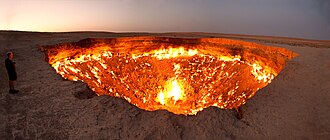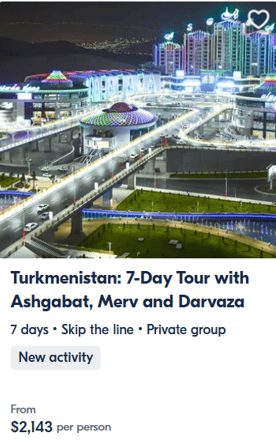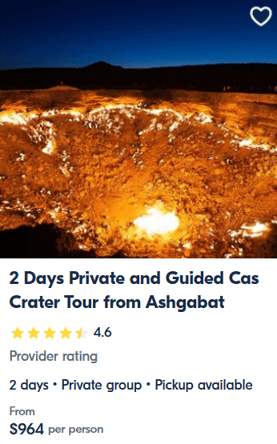Darvaza Gas Crater: The Burning Gates of Hell in Turkmenistan You Need to See Now


Deep in the Karakum Desert, a fiery pit has been burning for over half a century. Locals call it the "Door to Hell." Scientists call it an accidental disaster. But those who've stood at its edge call it something else entirely: the most assaulting sensory experience of their lives.
But here's the catch: Turkmenistan's government could close it to tourists at any moment. If you want to experience this infernal wonder in person, you'll need to move fast—and navigate one of the world's trickiest visa processes.
Ever dreamed of standing at the edge of what feels like the apocalypse itself? Let me take you there.
Approaching the Gates of Hell
The journey begins with a bumpy ride across the Karakum Desert in a Soviet-era 4x4. Miles from anything resembling civilization, you'll see it first as an orange glow on the horizon—easily mistaken for the setting sun, except it's midnight.
The crater plays tricks on your mind from the very beginning. Travelers often check their watches, confused by what looks like sunrise at 2 AM.
As you approach, the first thing that hits you isn't the sight—it's the sound. A deep, constant whoosh like a Boeing 747 preparing for takeoff fills the desert air. Then comes the smell—an overwhelming assault of hydrogen sulfide that makes most first-timers instinctively gag.
Many visitors turn back at this point, claiming they've seen enough from a distance. But they haven't seen anything yet.
The Untold Story Behind the Flames
The official story goes that in 1971, Soviet engineers accidentally drilled into a massive natural gas cavern. The ground collapsed beneath their equipment, forming a crater. Fearing the spread of toxic methane gas, they made a fateful decision—set it on fire and burn off the gas.
It was supposed to last a few weeks.
Instead, it's been burning for over 50 years.
But is that the whole story? Perhaps not. Some conspiracy theories suggest Soviet geologists may have known about the risks but proceeded anyway. Others claim the ignition might have been a deliberate burn-off to prevent a catastrophic methane explosion similar to the Lake Nyos disaster. KGB files potentially hold the truth, but Turkmenistan's archives remain sealed to this day.
Whether accident or calculated risk, the result is the same: a perpetual inferno that appears supernatural in its persistence and intensity.
Standing at the Edge of Oblivion: What No Photo Can Capture
As you take your final steps toward the crater's edge, your entire body registers danger. The heat hits you like opening an industrial oven—even from 15 feet away, your exposed skin begins to crisp within minutes. Visitors often retreat with sunburn-like redness after a brief viewing, despite being there after dark.
Most tourists overestimate how long they can stay. The combination of 115°F air, zero humidity, and the radiation from the flames creates a physical assault few can withstand for more than 30 minutes.
The perfectly circular pit drops 30 meters down, its walls alive with thousands of individual flames. They don't just burn steadily—they spiral and coil like living things, creating what locals call "fire serpents." Every few minutes, a pocket of gas detonates with a gunshot-like BANG, sending a fireball 20 feet into the air.
The desert floor beneath your feet subtly vibrates with underground gas movement. Place your palm on the ground, and you'll feel rhythmic pulses, as if the earth itself is breathing.
Experienced guides warn first-timers to keep their mouths closed near the crater. Open it for even a minute, and a metallic bitterness will coat your tongue for hours. Even sealed water bottles absorb the stench after a few hours—adding lemon helps mask it.
The Psychological Impact: Between Awe and Terror
As night fully descends, the crater's glow stains the surrounding sand deep crimson—the "Blood Dunes" effect that makes it appear as if the desert itself is bleeding. This is when the visual hallucinations often begin.
It's not supernatural—it's the combination of heat distortion, gas particles, and our brain's attempt to make sense of this alien environment. But knowing the science doesn't make it any less unsettling when you see what appears to be figures darting at the crater's rim, only to vanish when you try to focus on them.
Nearly everyone who stays after midnight reports seeing something in their peripheral vision—shadow people, dancing lights, or strange movements that defy explanation. The Turkmen guides call it "the devil's trick" and dismiss it with nervous laughter.
Your clothes will reek for days. No amount of washing removes it completely. It's like the crater marks you, making sure you don't forget.
The Physical Toll: Why Most Visitors Last Only 90 Minutes
Despite the spectacle's draw, the human body can only withstand the crater's assault for so long:
Most tourists manage just 30 minutes at the edge before heat exhaustion risk forces retreat.
With regular breaks to the cooler 4x4, some stretch their visit to 60 minutes.
Only researchers with industrial-grade respirators typically remain for up to 120 minutes.
Your shoes are the first casualty of a visit. The sand temperatures near the edge hit 300°F. Cheap sneakers start warping after an hour—soles literally separate from uppers. And anything plastic you're carrying? It softens like butter.
The crater's soundscape compounds the physical strain. The combination of the deep roar, the crackling explosions, and the wind creating eerie harmonic shrieks through the fissures (what locals call "the desert's cry") creates a continuous assault on your nervous system.
You don't just see the Gates of Hell. You hear it, smell it, taste it, and feel it in your bones. It's the closest thing to visiting another planet without leaving Earth.
Can You Really Visit the Gates of Hell?
Yes—but it's not easy. Turkmenistan remains one of the world's most closed-off countries, with entry procedures that rival North Korea's—just with a fiery pit of doom as the main attraction.
Getting to the Gates of Hell requires navigating a strict process that trips up many would-be visitors. First, you must secure your tour before leaving your home country, as your visa application hinges entirely on having confirmed travel arrangements. Without a pre-booked tour, your application will be rejected before you even pack your bags.
The bureaucratic gauntlet includes obtaining a letter of invitation from a Turkmen tour agency (without it, your visa application is dead on arrival), booking a guided tour (this vetted Darvaza tour handles permits and avoids detention risks), and providing a valid reason for visiting that satisfies notoriously inconsistent approval standards.
Once these hurdles are cleared, most visitors fly into the capital, Ashgabat, before embarking on their desert expedition to the crater. The journey culminates in what seasoned travelers unanimously agree is the optimal experience—an overnight stay that allows you to witness the flames against the night sky. As darkness falls completely, the crater's full intensity reveals itself in a truly otherworldly display that photographs simply cannot capture. This moment, when the inferno dominates the black desert night, is what makes navigating Turkmenistan's byzantine entry requirements worthwhile.
Essential Gear For Surviving Hell
Based on the experiences of those who've made the journey, here's what you absolutely need:
Heat-resistant footwear – Sturdy hiking boots with thick rubber soles are mandatory. Tennis shoes or fashion boots will literally melt.
Protective eyewear – The combination of extreme dryness, heat, and particulates makes goggles or wraparound sunglasses essential.
Neck gaiter/face covering – To filter the worst of the sulfur smell and protect your respiratory system.
Aluminum water bottle with lemon slices – Plastic absorbs the odors, and the lemon helps mask the inevitable sulfur taste.
High-SPF moisturizer – Even at night, the radiant heat causes sunburn-like effects on exposed skin.
Camera with heat protection – Electronics fail quickly near the crater. Wrap cameras in insulating material when not in use.
Will the Gates of Hell Close to Tourists?
There's no official ban on visits yet, but the signs are worrying:
The government has discussed extinguishing the crater for environmental reasons.
Access to remote areas of Turkmenistan changes frequently based on political whims.
Visa approvals vary dramatically by season and current diplomatic climate.
Bottom line: if witnessing this wonder is on your bucket list, don't wait. The door to Hell might slam shut forever. Book a tour now before this opportunity disappears forever
Your Ticket to the Gates of Hell: The Turkmenistan Visa Guide
Getting a visa is the biggest hurdle—but it's not impossible if you know the right steps. The bureaucratic process can be overwhelming for foreigners. Many applicants find the visa process particularly challenging, especially for the tourist visa needed for these kinds of excursions.
The visa application process is known to reject perfectly qualified applicants for minor paperwork issues or incomplete documentation. Without proper guidance, you could spend months preparing an application only to be rejected for a technical error.
First-time applications are frequently rejected for seemingly trivial reasons—using blue ink instead of black on a form, submitting photos that are millimeters off the required dimensions, or forgetting to include a seemingly minor document. These rejections come without explanation and after weeks of waiting.
Want a foolproof blueprint?
[GET] The Ultimate Guide to Turkmenistan Visa Application
Inside this FREE guide, you'll discover:
The exact documents required for visa approval (and common mistakes that lead to instant rejection)
How to secure an invitation letter without overpaying sketchy "visa agencies"
Tips to avoid common rejection reasons that trip up 70% of first-time applicants
Don't let bureaucracy stand between you and one of Earth's most extraordinary sights. This comprehensive guide will walk you through each step of the process, from initial application to arrival in Turkmenistan.
Final Warning: This Wonder Won't Last Forever
The Darvaza Crater is a once-in-a-lifetime spectacle. But between shifting government policies and environmental concerns, it might not be accessible much longer.
When you return home, friends will ask if you saw anything "nice" in Turkmenistan. Nice isn't the word. The Gates of Hell isn't beautiful—it's terrible in the original sense of the word. It inspires terror, awe, and a kind of primal fascination. Your clothes will stink, your camera might be damaged, and you'll have nightmares about those flames for weeks. And yet, it will be one of the most profound experiences of your life.
Your move. Will you face the Gates of Hell before they close forever? Secure your spot on a Darvaza tour here.
Disclosure: I earn a small fee if you book via my links—this supports my blog at no extra cost to you
Explore
Discover hidden gems and travel like locals.
© 2025 TheBorderlessCompass.com. All rights reserved
Terms and Conditions
Have a question? reach us at info@theborderlesscompass.com








